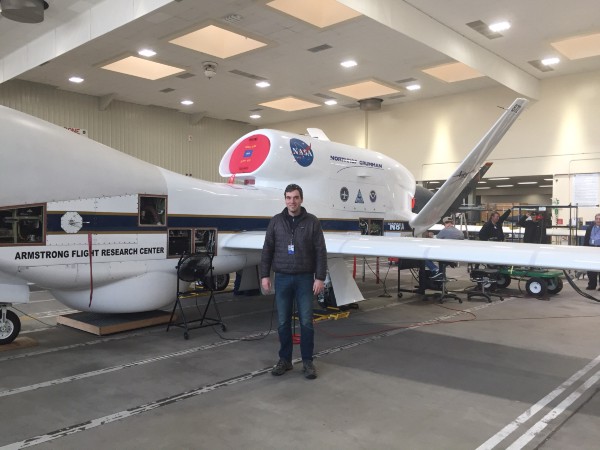Blowing in the windFebruary 1, 2016by Gijs de Boer (CIRES)

Blowing in the wind
February 1, 2016by Gijs de Boer (CIRES)
EDWARDS AIR FORCE BASE, California — This morning, we began official operations for the NOAA/NASA Global Hawk unmanned aircraft. Interestingly, the exact types of weather we’re interested in observing significantly impacted several team members in their travels to Edwards Air Force Base in southern California. For me, the strong winds and rain associated with yesterday’s atmospheric river event only resulted in slight delays and a bumpy ride into Burbank airport. For some of our other mission science team members (who were also flying into Burbank), it meant a diversion to San Jose, followed by a long, late, 5+ hour drive south on I-5. As of mid-morning, everyone is accounted for and busily preparing for the weeks ahead.
 Gijs in the hangar with the Global Hawk.
Gijs in the hangar with the Global Hawk.
The strong winds are also impacting our operations — the range flight that was potentially scheduled for today had to be postponed because of conditions here at Edwards. The Global Hawk has a limited range of wind conditions that allow it to launch and land, and this morning did not fit within this envelope. Based on the winds that I saw coming over the mountains from Burbank this morning, and forecast wind gusts of 50+ MPH, I wasn’t surprised. Unfortunately, science flights can’t be executed until this range flight is completed, and so our first potential science flight won’t happen until Wednesday at the earliest.
 Gary Wick (left) and Jason Dunion working on a flight plan.
Gary Wick (left) and Jason Dunion working on a flight plan.
The rest of the day will be spent getting things set up for the coming flights. As one might imagine, a campaign of this scale requires substantial coordination, and much of our day is taken up with teleconferences linking Colorado, Hawaii, California and beyond. The rest of the time is spent planning for potential flights. The weather pattern for the coming week is shifting to one that is favorable for relatively quiet conditions along the coast of California. Since the Global Hawk will be looking to make measurements that could help to link El Niño to high-impact weather here, that means that we may have reasons for saving our limited (4) flights for a more active window later in the campaign. Because we need to file flight plans well in advance, it’s tricky to walk the line between being prepared to fly and not wasting time on periods that are less interesting to sample. The weather impacting the west coast (mainly Washington and Oregon) this weekend is interesting enough that we’re keeping our options open for a flight this week — more on that soon!
By CIRES on February 2, 2016.
Exported from Medium on January 12, 2017.
